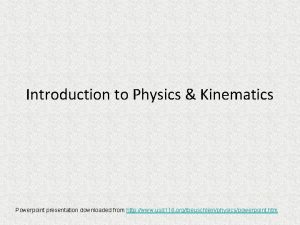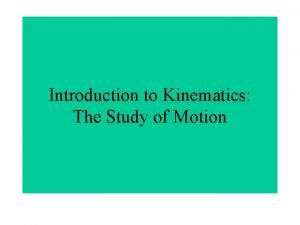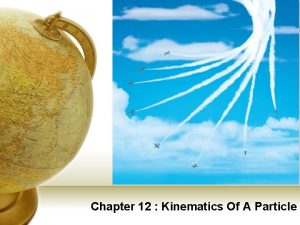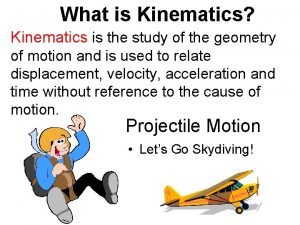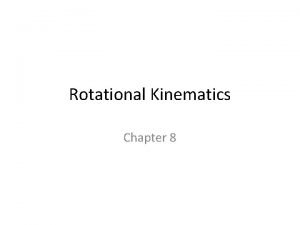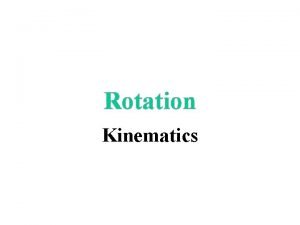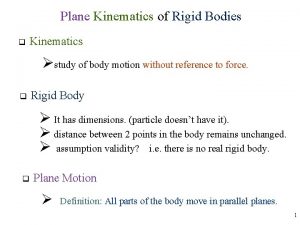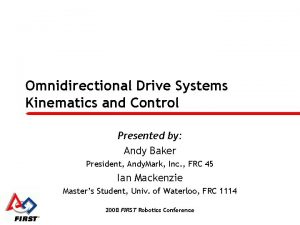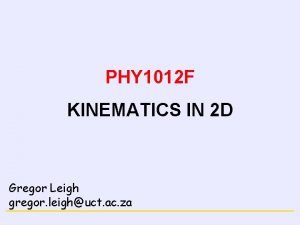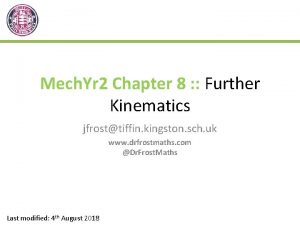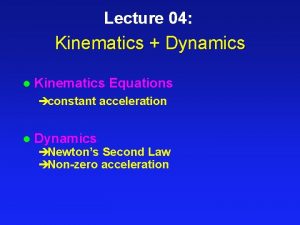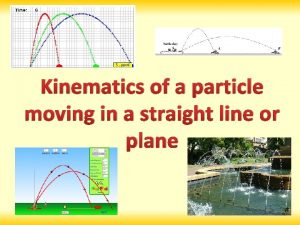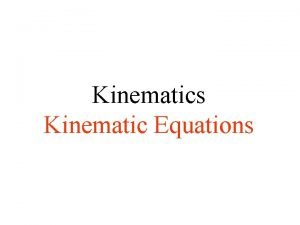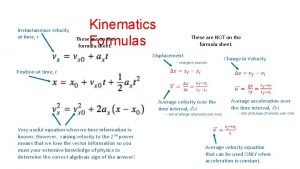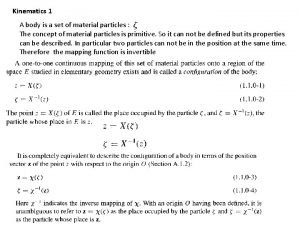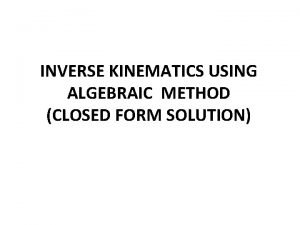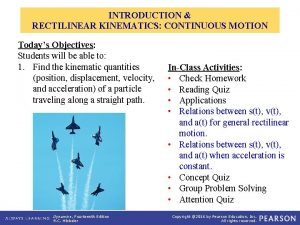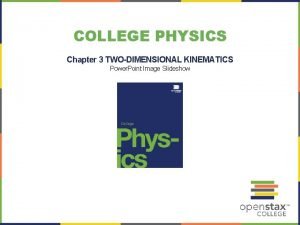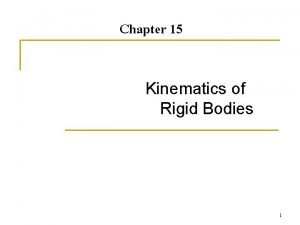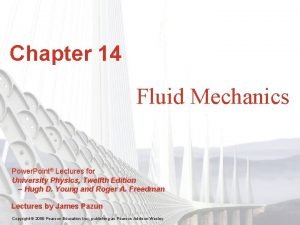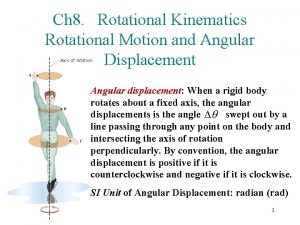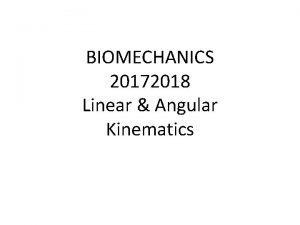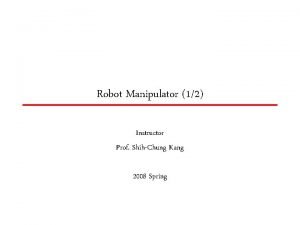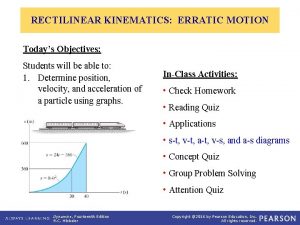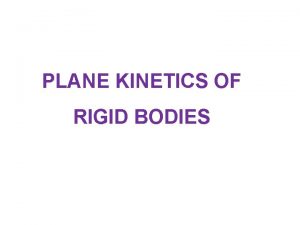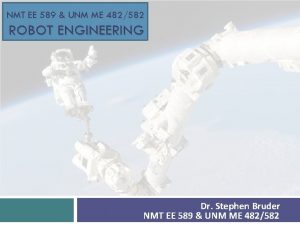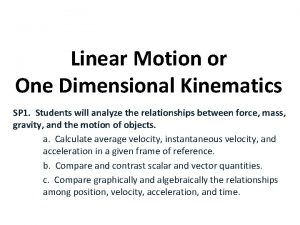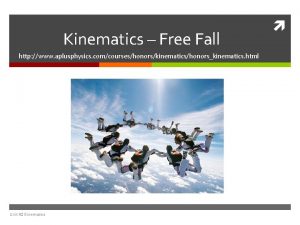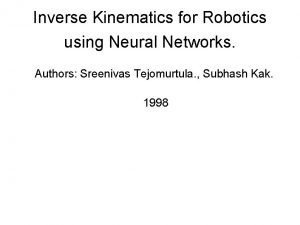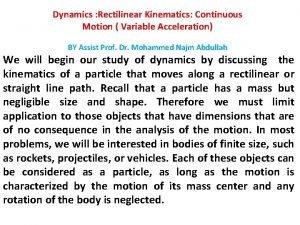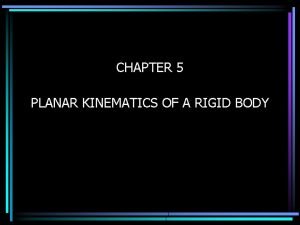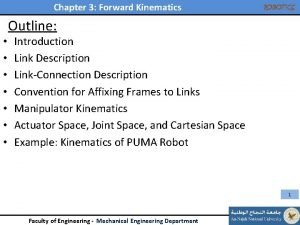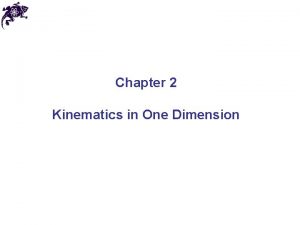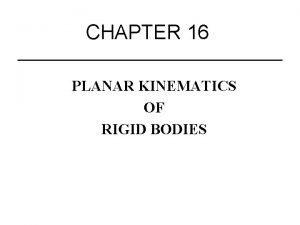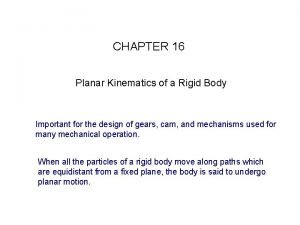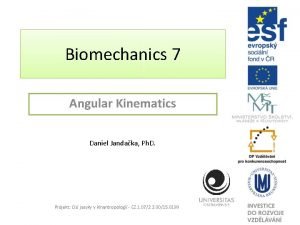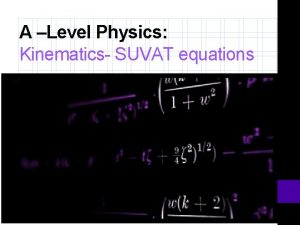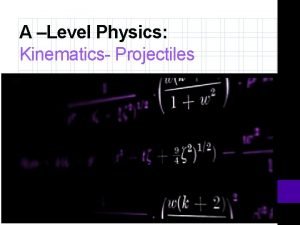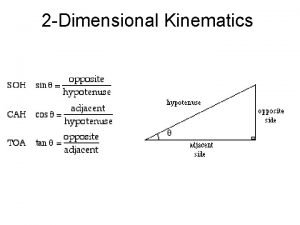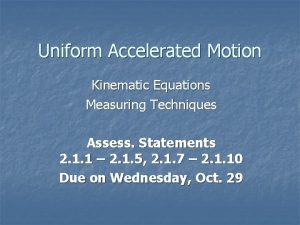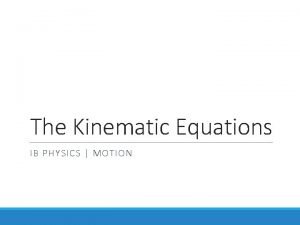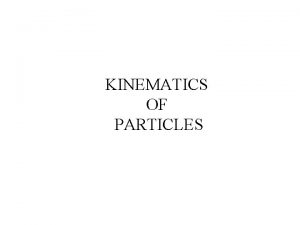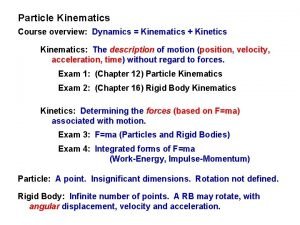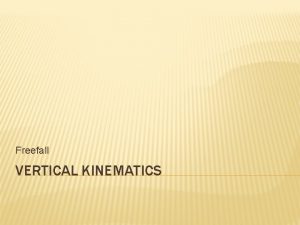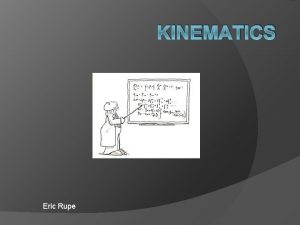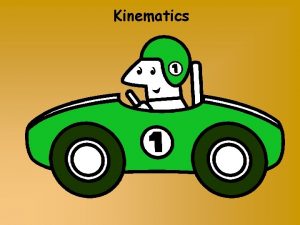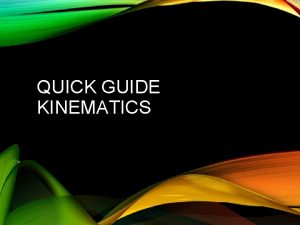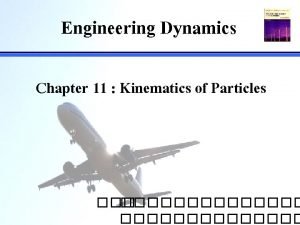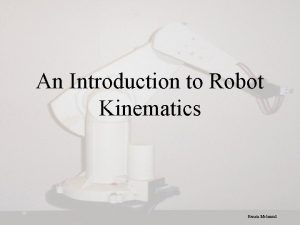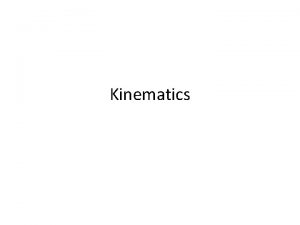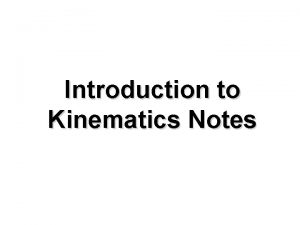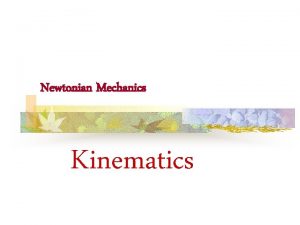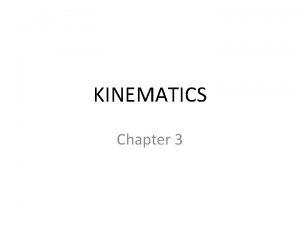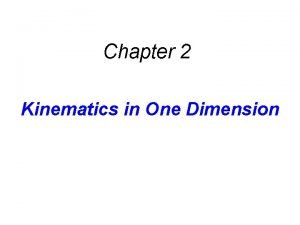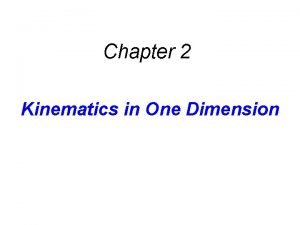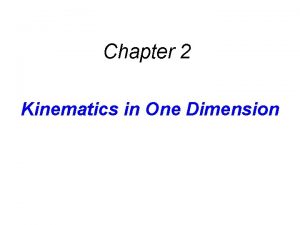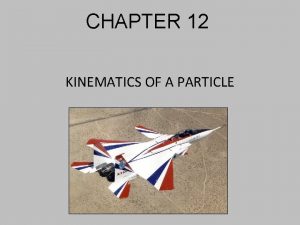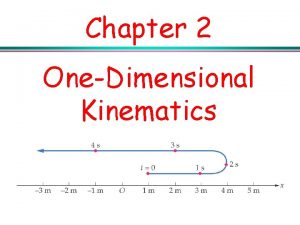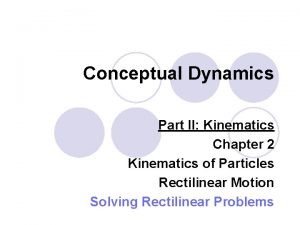CHAPTER 11 Kinematics of Particles 11 1 INTRODUCTION

















































- Slides: 49

CHAPTER 11 Kinematics of Particles

11. 1 INTRODUCTION TO DYNAMICS n n Galileo and Newton (Galileo’s experiments led to Newton’s laws) Kinematics – study of motion Kinetics – the study of what causes changes in motion Dynamics is composed of kinematics and kinetics

RECTILINEAR MOTION OF PARTICLES

11. 2 POSITION, VELOCITY, AND ACCELERATION For linear motion x marks the position of an object. Position units would be m, ft, etc. Average velocity is Velocity units would be in m/s, ft/s, etc. The instantaneous velocity is

The average acceleration is The units of acceleration would be m/s 2, ft/s 2, etc. The instantaneous acceleration is

Notice If v is a function of x, then One more derivative

Consider the function x(m) Plotted 32 16 0 2 4 6 t(s) v(m/s) 12 0 t(s) -12 -24 -36 a(m/s 2) 12 0 -12 -24 t(s)

11. 3 DETERMINATION OF THE MOTION OF A PARTICLE Three common classes of motion




with then get

or Both can lead to

11. 4 UNIFORM RECTILINEAR MOTION

11. 5 UNIFORMLY ACCELERATED RECTILINEAR MOTION Also

11. 6 MOTION OF SEVERAL PARTICLES When independent particles move along the same line, independent equations exist for each. Then one should use the same origin and time.

Relative motion of two particles. The relative position of B with respect to A The relative velocity of B with respect to A

The relative acceleration of B with respect to A

Let’s look at some dependent motions.

G x. A C D x. B A E F B System has one degree of freedom since only one coordinate can be chosen independently. Let’s look at the relationships.

x. C x. A C A B System has 2 degrees of freedom. Let’s look at the relationships. x. B

11. 7 GRAPHICAL SOLUTIONS OF RECTILINEAR-MOTION n Skip this section.

11. 8 OTHER GRAPHICAL METHODS n Skip this section.

CURVILINEAR MOTION OF PARTICLES 11. 9 POSITION VECTOR, VELOCITY, AND ACCELERATION y P’ P x Let’s find the instantaneous velocity. z

y P’ P x z

y x y z P’ Note that the acceleration is not necessarily along the direction of the velocity. P x z

11. 10 DERIVATIVES OF VECTOR FUNCTIONS


Rate of Change of a Vector The rate of change of a vector is the same with respect to a fixed frame and with respect to a frame in translation.

11. 11 RECTANGULAR COMPONENTS OF VELOCITY AND ACCELERATION

y y P x z

y x z

Velocity Components in Projectile Motion

11. 12 MOTION RELATIVE TO A FRAME IN TRANSLATION y’ B y A O z z’ x x’



11. 13 TANGENTIAL AND NORMAL COMPONENTS Velocity is tangent to the path of a particle. Acceleration is not necessarily in the same direction. It is often convenient to express the acceleration in terms of components tangent and normal to the path of the particle.

Plane Motion of a Particle y P’ P O x



y P’ P O x

Discuss changing radius of curvature for highway curves

Motion of a Particle in Space y P’ P O z The equations are the same. x

11. 14 RADIAL AND TRANSVERSE COMPONENTS Plane Motion y P x



y x

Note

Extension to the Motion of a Particle in Space: Cylindrical Coordinates
 Aplusphysics kinematics-horizontal kinematics
Aplusphysics kinematics-horizontal kinematics Introduction to kinematics ppt
Introduction to kinematics ppt Introduction to kinematics
Introduction to kinematics Kinematics of a particle
Kinematics of a particle Ions charged particles in solution
Ions charged particles in solution Differential drive inverse kinematics
Differential drive inverse kinematics What is kinematics
What is kinematics Sin 37°
Sin 37° Rotational kinematics
Rotational kinematics Rotational kinematic equations
Rotational kinematic equations Plane kinematics of rigid bodies
Plane kinematics of rigid bodies Omni projectile motion calculator
Omni projectile motion calculator Laws of kinematics
Laws of kinematics Dr frost further kinematics
Dr frost further kinematics Kinematic equations
Kinematic equations Kinematics of a particle
Kinematics of a particle Kinematic equatiobs
Kinematic equatiobs Kinematics formula sheet
Kinematics formula sheet Transport theorem kinematics
Transport theorem kinematics Inverse kinematics
Inverse kinematics Find jacobian matrix
Find jacobian matrix Rectilinear kinematics: continuous motion
Rectilinear kinematics: continuous motion What is continuous motion in dynamics
What is continuous motion in dynamics Timeline fluid mechanics
Timeline fluid mechanics Kinematics ppt
Kinematics ppt Coriolis acceleration kinematics
Coriolis acceleration kinematics Kinematics and kinetics of rigid bodies
Kinematics and kinetics of rigid bodies Fluid kinematics - ppt
Fluid kinematics - ppt Unit of angular acceleration
Unit of angular acceleration Linear and angular kinematics
Linear and angular kinematics Forward kinematics
Forward kinematics What is erratic motion
What is erratic motion Kinetics of rigid bodies
Kinetics of rigid bodies Nmt.ee
Nmt.ee Motion with constant velocity
Motion with constant velocity Aplusphysics ucm gravity answer key
Aplusphysics ucm gravity answer key Inverse kinematics
Inverse kinematics Rectilinear kinematics continuous motion
Rectilinear kinematics continuous motion Types of motion with examples
Types of motion with examples رباتيك
رباتيك A tourist being chased by an angry bear
A tourist being chased by an angry bear Planar rigid body
Planar rigid body Planar kinematics of a rigid body
Planar kinematics of a rigid body Angular kinematics biomechanics
Angular kinematics biomechanics Suvat eq
Suvat eq A level physics kinematics
A level physics kinematics Salmon often jump waterfalls to reach
Salmon often jump waterfalls to reach Kinematic equations for uniformly accelerated motion
Kinematic equations for uniformly accelerated motion Kinematics ib physics
Kinematics ib physics Kinematics of simple harmonic motion
Kinematics of simple harmonic motion

